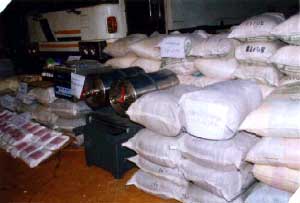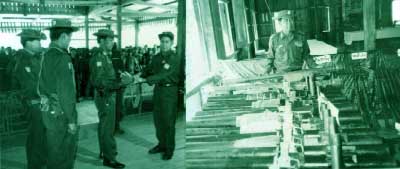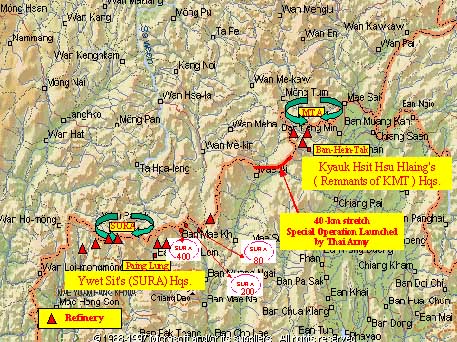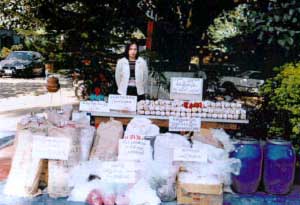Terrorists at
Thai-Myanmar border and the drug problem
| Newspapers in Thailand highlighted a report on
the seizure from two Thai nationals in Thailand with two SAM-7 missiles. They said that the two Thai nationals were arrested together with 100 stimulant tablets and two SAM-7s at their houses, that the weapons were purchased at the Cambodian border and would be sold to the group in southern Wa area, that based on the news the Wa group had surface-to-air missiles and so Thai Commander-in-Chief of the Armed Forces General Surayut Chulanont said the aircraft of the Thai Air Force were not to fly along the Thai-Myanmar border. Myanmar is located in the South-East Asia region and it has common borders with her neighbours stretching altogether 6,099 kilometres. It also shares the border with Thailand stretching 2,096 kilometres. Moreover, the geographic al conditions along the border is characterised by forests and mountains. With poor transport and communication links there are restraints in transport.
|
||||
|
||||
|
Prior to 18 September 1988, the armed groups took advantage of the long stretch of the Thai-Myanmar border, difficult transport and communication links, rugged terrains and convenient supply of food and arms from Thailand they established strong camps along the border. From those bases they committed destructive acts and engaged in illicit production of narcotic drugs and trafficking. From 18 September 1988 onwards, the so-called democracy activists absconded to the Thai-Myanmar border areas and Thailand. They colluded with the armed groups and committed subversive acts. Moreover, they formed different groups under different names in Bangkok, secured assistance from the anti-government groups in foreign nations and carried out sabotage acts. Up to that time Thai businessmen in collusion with the armed groups at the border carried out illegal extraction of valuable timber and minerals and smuggled them out of the country. They also engaged in gunrunning. Since then, heavy weapons like SAM-7 and 2.75 launchers and other weapons, explosives and mines have got into the hands of the armed groups via Thailand. Securing food supplies and arms from illegal sources in Thailand, KNU and KNPP armed groups have been able to continue to settle along the common border in Thailand and carry out subversive acts. MTA group led by Khun Sa in particular purchased anti-aircraft machine-guns and guided missiles like SAM-7s, heavy and small arms from sources in Thailand with the proceeds from the drug trafficking, called in foreign instructors to Homain, MTA headquarters, for military training, hired weapons experts and produced weapons like launchers, rockets, heavy and small arms, bombs, mines and explosives at Homain. The group did so in order to strengthen itself. When the MTA group unconditionally surrendered in 1996, the weapons included 20 SAM-7s and anti-aircraft machine-guns plus heavy and small weapons totalling more than 9,000 as well as bombs, mines and explosives numbering more than two million. Of them the US-made arms and ammunition were the largest in number. Some were found to bear markings of the Thai military. Moreover. arms and ammunition seized from KNU armed group during military operations included those bearing the markings of the Thai military. It is an undeniable fact that the armed groups along the Thai-Myanmar border are receiving heavy and small arms, launchers, bombs and explosives from illegal sources in Thailand as stated above: The seizure of the China-made two SAM-7s on 7 September 1999 is not strange. A study of the above facts will show that the case is not an unusual one.
|
||||
|
||||
From June 1999, the Thai dailies like Bangkok Post and T£1e Nation have been reporting that stimulant tablets and heroin were produced along the Thai-Myanmar border in Myanmar, that the government was ignoring the drug trafficking carried out by ethnic armed groups, that Khun Sa, had resumed drug trafficking, that the Myanmar Tatmadaw was involved in drug trafficking, that regional development projects such as road building, dam construction and power supply projects in Mongyawn in eastern Shan State were implemented by the southern Wa group with the use of money realized from drug trafficking. The papers mad e irresponsible and one-sided assessment of the events. Thailand faced the problem of stimulant drugs about ten years ago and it became a major issue among the students of basic education schools and universities/colleges beginning 1996. |
||||
|
Hence, Thailand has taken suppressive measures against stimulant drugs as a national campaign starting from early 1999. Moreover, the Royal Thai Army is said to have led a special operation targeting 26 villages along the Thai-Myanmar border in Mae-aing, Chiang Mai and Chiang Mai districts beginning from 15 July 1999. The fact that the Thai Army launched the special operations against the area opposite the Lwe Hsan Saw area in southern Wa region while leaving the areas where SURA Ywet Sit group are engaged in subversive acts and drug trafficking, MTA remnant Kyauk Hsit Hsu Hlaing group and KMT remnants were active with their base in Paing Lung and Ban-Hin Tak on Thai side of the border; it is food for thought. |
|||
|
Since stimulant tablets are more profitable, drug traffickers have turned to production of these tablets. Ephedrine, a precursor item for manufacturing stimulant tablets was exposed and seized starting from the late 1996. Myanmar is located between China and India, the two nations which produce the largest amount of Ephedrine. The chemicals illegally enter the country across the long stretch of the common borders with these two countries. It also comes from Thailand. As a counter measure, Myanmar increased its cooperation with her neighbours China, India and Thailand. The problem of stimulant tablets has started in the region since the last decade. India and Thailand were the first to face the problem but Myanmar began to experience it in the late 1996. The seizures in Tachilek on 3-1-99 and in Hsenwi on 21-7-99 will show that precursor chemicals, electric power and machinery required for producing stimulant drugs entered the country across the borders with neighbouring countries. Similarly, the seizures of Ephedrine, dyes and Methamphetamine tableting machines prove this. Drug traffickers have brought in those materials to the border areas through all available means by taking advantage of the long stretch of borders with the neighbouring countries, rugged mountains and natural barriers like difficult transport and communication links and are reported to be illegally producing the drugs along the border. |
||||
The Lwe Hsan Saw area in southern Wa group alleged to have been related to the
problem of stimulant tablets in Thailand is not a separate Wa group. It is the group
under control of U Pauk Yu Chan at Pangsang Headquarters. The group is reported to be
implementing projects on building of roads, dams and power generation plants in Mongyawng after obtaining
machinery and technical assistance from Thailand. In connection with the allegations
against the southern Wa group, officials of the Thai drug control authorities themselves visited the
area in May 1999 and met the responsible personnel of the southern Wa
group.
The Lwe Hsan Saw area in southern Wa group alleged
 |
| 791
kilos of Ephedrine, 1,101.05 kilos of other chemicals, Methamphetamine Tableting Machine and paraphernalia illegally brought in from Thailand and India and seized at Hsenwi camp on 21-7-99. |
to have been related to the
problem of stimulant tablets in Thailand is not a separate Wa group. It is the group
under control of U Pauk Yu Chan at Pangsang Headquarters. The group is reported to be
implementing projects on building of roads, dams and power generation plants in Mongyawng after obtaining
machinery and technical assistance from Thailand. In connection with the allegations
against the southern Wa group, officials of the Thai drug control authorities themselves visited the
area in May 1999 and met the responsible personnel of the southern Wa group.
They have already known the cultivation of opium substitute crops, livestock breeding and measures for
alternative incomes to combat the drug problem. Despite this they have taken such one-sided action. So, it
is hard to understand.
It may be reviewed that drug problem has been in existence together with the
insurgency at the Thai-Myanmar border. The problem will remain so long as the terrorists are
allowed to exist. The Tatmadaw government has striven for national reconsolidation
to put an end to internal strife. Moreover, it has stepped up its cooperation with
neighbouring countries in narcotic drugs matters. Although the narcotic drugs constitute a global problem
there are attempts to heap blame on Myanmar and discredit her by those entertaining ill will towards
the country using the problem as a political trick. But such allegations will be
of disservice not only to the region but also to the entire world. Hence, instead of
pointing accusing fingers at others, collective efforts will have to be made world-wide.
The Thai newspapers should review and disclose without withholding anything who are giving support to enable
the terrorists to continue to exist at the Thai-Myanmar border and who are connected with the narcotic
drugs business if they are truly desirous of eliminating the narcotic problem. At the
same time, it will be necessary to realize the fact that narcotic drugs problem can successfully be solved
through cooperation between the two countries.
![]()


